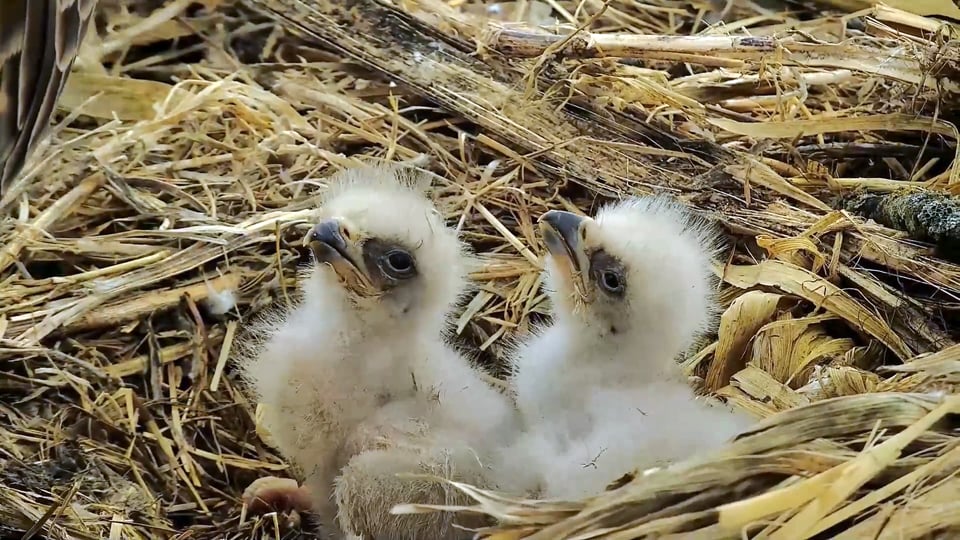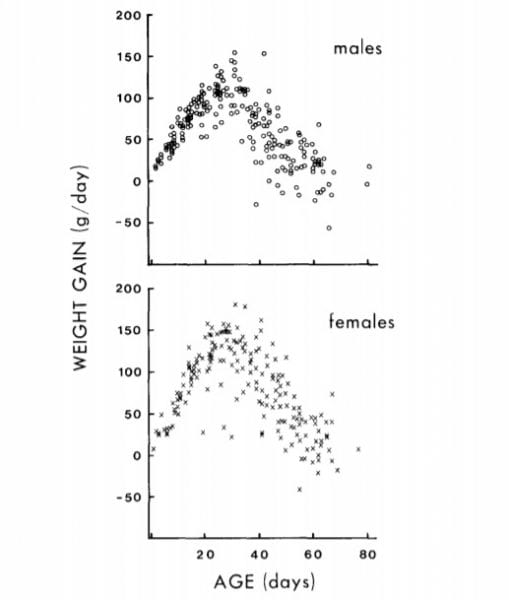We’re writing a series of blogs about the first few weeks of an eaglet’s life. An eaglet spends roughly 75 to 80 days in the nest. For about the first half, it grows and gains weight. For about the second half, it grows flight feathers and starts developing the skills it will need post-fledge. We will focus on week one in this blog.
 March 27, 2024: An Eagletude fit for royalty! DN17 and DN18 turned three and two days old today.
March 27, 2024: An Eagletude fit for royalty! DN17 and DN18 turned three and two days old today.
What can we expect in the first week following hatch? Like humans, a growing eaglet has developmental milestones. Eaglets spend roughly the first week of their life growing, going from about 3.2 ounces to roughly 16 ounces or one pound: a fivefold increase in just seven days! They spend most of their first week eating, begging for food, sleeping, and exploring the confines of their parents’ feathery coverlets.
Some things to watch for…
- DN17 and 18 are growing stronger and more coordinated as they interact with their parents. At just a few days old, they can sit up for feedings and lunge at food. By the end of the week, they will be able to sit up – way up! – and grab larger morsels of flesh from DNF and Mr. North’s beaks.
- Neither eaglet can stand on its (growing) feet yet, but they should be relatively adept at shuffling around on their metatarsi by the end of the week, assuming the weather cooperates!
- They will begin excreting. Check out this tiny adorable poop shoot from last year! https://youtu.be/CZ1azg2lYNA.
- Their large eyes are receding into their sockets. By the end of the week, they will be tracking Mr. North and DNF’s entrances into and exits from the nest.
- Little hatchlings aren’t able to thermoregulate yet, so we won’t see much of them if the weather stays cold and wet.
 Weight gain (g/day) as a function of age for male and female nestling Bald Eagles. This chart was reprinted from The Wilson Bulletin 96: 527 from an article published by G. R. Bartolotti (1984) with the written permission of the Wilson Ornithological Society.
Weight gain (g/day) as a function of age for male and female nestling Bald Eagles. This chart was reprinted from The Wilson Bulletin 96: 527 from an article published by G. R. Bartolotti (1984) with the written permission of the Wilson Ornithological Society.
How do eaglets grow? Unlike balloons, they don’t inflate evenly. Most body parts don’t really take off until 10-15 days following hatch, although the eaglets’ mid-toes and culmens (the dorsal ridge of their upper mandibles) are already getting larger! Food is the root of all else besides, so it isn’t surprising that the culmen achieves maximum growth in the first ten days. I suspect that the mid-toe aids balance, a crucial element of sitting up and exploring the nest. While eaglets don’t stand on their feet until they are roughly four weeks old, they will begin to shuffle around the nest on their tarsi long before that.
Enjoy our downy bobbleheads this week! By next week, they will already be growing their longer ‘wooly’ second or thermal down and alternately worrying and thrilling us with their sojourns around the nest.
Developmental Stages
The general stages of eagle development are:
- Stage 1 – Structural growth. In their first thirty-five to forty days of life, eagles grow very rapidly, gaining weight and building bones, muscles, tissue, and features like tarsi, footpads, toes, and claws. This phase of development slows down about halfway through an eaglet’s time in the nest, even though individual features might continue some level of growth.
- Stage 2 – Feather and flight-related growth. Eagles grow four sets of feathers – natal down inside the egg, thermal down, juvenile feathers, and adult feathers. While thermal down starts growing at about ten days and juvenile flight feathers at about 27 days, feather growth doesn’t overtake structural growth until thirty-five to forty days after hatch. Flight muscles also begin growing as eaglets wingercize, flap, hover, and eventually branch and fledge.
- Stage 3 – Neurological Coordination. Eagle watchers know how ungainly eaglets can seem! As they grow, they become more adept at controlling beaks, legs, wings, and feet. They learn to stand on their own feet, tear food, self-feed, and flap their wings, going from cute but clumsy clown clompers to graceful young eaglets poised at the edge of fledge.
I’m not sure how familiar many of you are with the cortical homunculus, an image-based tool that maps tactility. We discussed it very briefly in this blog and I’ll include links below (Amy’s note: yes, this remains an obsession). While useful and extremely cool, most cortical homunculii are static – that is, they reflect just one phase (usually adult) of an organism’s life. But an eaglet’s cortical homunculus will differ from an adult’s as body parts and associated skills are gained and neural pathways developed. Our eaglets’ brains and bodies are rapidly growing and changing as they gain the skills they need for life outside the egg!
Sources
Things that helped me write this blog, with a few considerations:
- Eaglet hatch weight is based on Gary Bortolotti’s work with eaglets at Besnard Lake in Canada. It is possible that our eaglets are a little smaller than his, since bald eagles get bigger the farther north one travels: a phenomena known as Bergmann’s Rule. Bortolotti’s paper makes for interesting reading and provides a great look at the work involved in field science. Citation: Physical Development of Nestling Bald Eagles with Emphasis on the Timing of Growth Events, The Wilson Bulletin, Vol. 96, No. 4 (Dec., 1984), pp. 524-54. https://www.usask.ca/biology/bortolotti/pubs/wb96-4-524-542.pdf. Thanks to The Wilson Ornithological Society for their permission to use this chart.
- Mouseunculus: http://phenomena.nationalgeographic.com/2013/07/24/mouseunculus-how-the-brain-draws-a-little-you/
- Homunculus: http://io9.com/5670064/how-your-brain-sees-your-body-meet-the-cortical-homunculus
- Input from Bob Anderson, who imparted much wisdom and information before he passed.
- RRP moderators and their calendars, lists, books, charts, and personal observations.
 The Raptor Resource Project
The Raptor Resource Project The Raptor Resource Project
The Raptor Resource Project